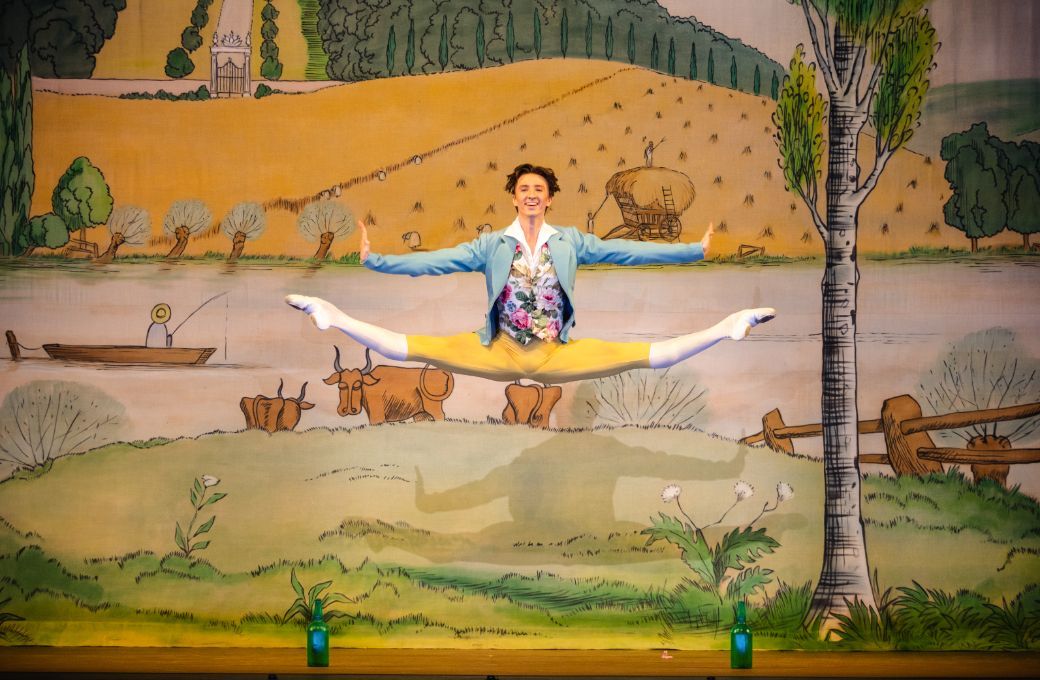There are times in history when, in a world that feels chaotic and unmanageable, art can come into its own as a healing force. Thus it was at the Royal Opera House at the opening night of La Fille mal gardée with The Royal Ballet, the most joyous of ballets providing a sunny, humorously romantic break from the slings and arrows of quotidian stresses.

Part of this lovely ballet’s charm lies in the simplicity of its story: boy loves girl, she loves him back, but her mother is determined to marry her to the doltish son of the neighbouring farmer, so that the two pieces of land can be amalgamated. Doltish son makes enough sufficiently embarrassing blunders for mother to cave in to the determination of the young lovers after they are caught kissing behind closed doors, and all turns out happily in the end.
For connoisseurs though there is so much more to this ballet than its simple narrative. Ashton’s flawlessly constructed choreography is texturally complex and provides intellectual reward for those interested in technique; the music is delightful; Osbert Lancaster’s charming front cloth is worth a visit in its own right and, last but not least, there’s Oscar the pony, impressively professional and unfazed by a small hoof slipping on the smooth stage surface during the front-of-cloth procession to the picnic.
Marianela Núñez and Vadim Muntagirov each received applause and cheering at their entrances, as well as after every solo no matter how short and their curtain calls were of the bringing-the-house-down variety, the stage awash in bouquets. They have become the rockstars of The Royal Ballet, a phenomenon that goes beyond “favourite dancers” and turns them into cultural institutions. There were some opening night jitters (a lift that didn’t quite reach its apogee, some turns that weren’t quite spot on) but this gave us the chance to marvel at the miracles dancers of this calibre can perform to rescue mishaps and carry on to even greater heights. Muntagirov, his pure classical technique gleaming from every step, every movement, every line, is quite simply a joy to watch, and he invested his Colas with sincere affection for Lise and effervescent joie de vivre. Núñez is extraordinary, and age simply cannot wither her; her work is as fresh today as when she first joined The Royal Ballet more than a quarter of a century ago.
The farmyard scene with the chickens in Act 1 was particularly well danced, especially by Daichi Ikarashi whose Cockerel had dynamic, beautifully worked legs and feet that lifted the role onto a different level. Ikarashi appeared again later as the Notary’s Clerk in Act 2: all pursed lips and prissy attention to detail, he made his mark even in this minor role.
The picnic scene at the core of the ballet will benefit from a little cleaning by rehearsal staff before the next performance, when I am sure the intricacies of the maypole dance with interweaving ribbons will be immaculate. Marco Masciari’s peasant flautist nearly stole the show with his sparkling entrechats and sublimely neat footwork, not to mention the ebullient charm with which he invests every performance, even in the back row of the corps de ballet. If ever there was a future star…
I also noticed lovely work from James Large, Ravi Cannonier-Watson and Mariko Sasaki. Thomas Whitehead’s Widow Simone is a nice mixture of a doughty widow doing the best she can with a headstrong daughter and an ageing girl who just wants to have fun. I liked Christopher Saunders’s soft-hearted Thomas, forever frustrated by his impossible son but loving him just the same.
One of the great pleasures among all these lovely performances was the Alain of Luca Acri, who has developed into an actor of quality as well as a very capable technician. Acri captures beautifully the touchingly awkward naivety of the bumbling misfit: we are rooting for him to find his own happiness from the moment he appears, even though we know he cannot possibly win Lise herself. This is right up there with the best Alains in living memory.
A special mention goes to Jonathan Lo, as always producing excellent cohesive work from the full orchestra as well some beautifully played solos, but also showing fine sensitivity to the dancers. I may have perceived an almost imperceptible tempo speed-up in the manège at the end of Colas’s first solo which helped it to a glittering conclusion.
If you’re in need of a pick-me-up, get thee to the Royal Opera House and see this gem of a ballet – there’s a long roster of impressive casts to choose from.


